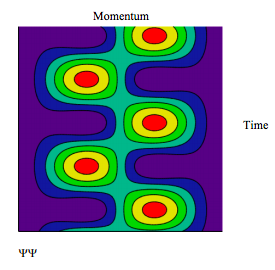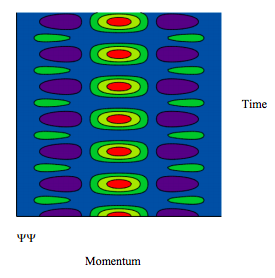4.13: The Quantum Jump in Momentum Space
- Page ID
- 150725
\( \newcommand{\vecs}[1]{\overset { \scriptstyle \rightharpoonup} {\mathbf{#1}} } \)
\( \newcommand{\vecd}[1]{\overset{-\!-\!\rightharpoonup}{\vphantom{a}\smash {#1}}} \)
\( \newcommand{\id}{\mathrm{id}}\) \( \newcommand{\Span}{\mathrm{span}}\)
( \newcommand{\kernel}{\mathrm{null}\,}\) \( \newcommand{\range}{\mathrm{range}\,}\)
\( \newcommand{\RealPart}{\mathrm{Re}}\) \( \newcommand{\ImaginaryPart}{\mathrm{Im}}\)
\( \newcommand{\Argument}{\mathrm{Arg}}\) \( \newcommand{\norm}[1]{\| #1 \|}\)
\( \newcommand{\inner}[2]{\langle #1, #2 \rangle}\)
\( \newcommand{\Span}{\mathrm{span}}\)
\( \newcommand{\id}{\mathrm{id}}\)
\( \newcommand{\Span}{\mathrm{span}}\)
\( \newcommand{\kernel}{\mathrm{null}\,}\)
\( \newcommand{\range}{\mathrm{range}\,}\)
\( \newcommand{\RealPart}{\mathrm{Re}}\)
\( \newcommand{\ImaginaryPart}{\mathrm{Im}}\)
\( \newcommand{\Argument}{\mathrm{Arg}}\)
\( \newcommand{\norm}[1]{\| #1 \|}\)
\( \newcommand{\inner}[2]{\langle #1, #2 \rangle}\)
\( \newcommand{\Span}{\mathrm{span}}\) \( \newcommand{\AA}{\unicode[.8,0]{x212B}}\)
\( \newcommand{\vectorA}[1]{\vec{#1}} % arrow\)
\( \newcommand{\vectorAt}[1]{\vec{\text{#1}}} % arrow\)
\( \newcommand{\vectorB}[1]{\overset { \scriptstyle \rightharpoonup} {\mathbf{#1}} } \)
\( \newcommand{\vectorC}[1]{\textbf{#1}} \)
\( \newcommand{\vectorD}[1]{\overrightarrow{#1}} \)
\( \newcommand{\vectorDt}[1]{\overrightarrow{\text{#1}}} \)
\( \newcommand{\vectE}[1]{\overset{-\!-\!\rightharpoonup}{\vphantom{a}\smash{\mathbf {#1}}}} \)
\( \newcommand{\vecs}[1]{\overset { \scriptstyle \rightharpoonup} {\mathbf{#1}} } \)
\( \newcommand{\vecd}[1]{\overset{-\!-\!\rightharpoonup}{\vphantom{a}\smash {#1}}} \)
\(\newcommand{\avec}{\mathbf a}\) \(\newcommand{\bvec}{\mathbf b}\) \(\newcommand{\cvec}{\mathbf c}\) \(\newcommand{\dvec}{\mathbf d}\) \(\newcommand{\dtil}{\widetilde{\mathbf d}}\) \(\newcommand{\evec}{\mathbf e}\) \(\newcommand{\fvec}{\mathbf f}\) \(\newcommand{\nvec}{\mathbf n}\) \(\newcommand{\pvec}{\mathbf p}\) \(\newcommand{\qvec}{\mathbf q}\) \(\newcommand{\svec}{\mathbf s}\) \(\newcommand{\tvec}{\mathbf t}\) \(\newcommand{\uvec}{\mathbf u}\) \(\newcommand{\vvec}{\mathbf v}\) \(\newcommand{\wvec}{\mathbf w}\) \(\newcommand{\xvec}{\mathbf x}\) \(\newcommand{\yvec}{\mathbf y}\) \(\newcommand{\zvec}{\mathbf z}\) \(\newcommand{\rvec}{\mathbf r}\) \(\newcommand{\mvec}{\mathbf m}\) \(\newcommand{\zerovec}{\mathbf 0}\) \(\newcommand{\onevec}{\mathbf 1}\) \(\newcommand{\real}{\mathbb R}\) \(\newcommand{\twovec}[2]{\left[\begin{array}{r}#1 \\ #2 \end{array}\right]}\) \(\newcommand{\ctwovec}[2]{\left[\begin{array}{c}#1 \\ #2 \end{array}\right]}\) \(\newcommand{\threevec}[3]{\left[\begin{array}{r}#1 \\ #2 \\ #3 \end{array}\right]}\) \(\newcommand{\cthreevec}[3]{\left[\begin{array}{c}#1 \\ #2 \\ #3 \end{array}\right]}\) \(\newcommand{\fourvec}[4]{\left[\begin{array}{r}#1 \\ #2 \\ #3 \\ #4 \end{array}\right]}\) \(\newcommand{\cfourvec}[4]{\left[\begin{array}{c}#1 \\ #2 \\ #3 \\ #4 \end{array}\right]}\) \(\newcommand{\fivevec}[5]{\left[\begin{array}{r}#1 \\ #2 \\ #3 \\ #4 \\ #5 \\ \end{array}\right]}\) \(\newcommand{\cfivevec}[5]{\left[\begin{array}{c}#1 \\ #2 \\ #3 \\ #4 \\ #5 \\ \end{array}\right]}\) \(\newcommand{\mattwo}[4]{\left[\begin{array}{rr}#1 \amp #2 \\ #3 \amp #4 \\ \end{array}\right]}\) \(\newcommand{\laspan}[1]{\text{Span}\{#1\}}\) \(\newcommand{\bcal}{\cal B}\) \(\newcommand{\ccal}{\cal C}\) \(\newcommand{\scal}{\cal S}\) \(\newcommand{\wcal}{\cal W}\) \(\newcommand{\ecal}{\cal E}\) \(\newcommand{\coords}[2]{\left\{#1\right\}_{#2}}\) \(\newcommand{\gray}[1]{\color{gray}{#1}}\) \(\newcommand{\lgray}[1]{\color{lightgray}{#1}}\) \(\newcommand{\rank}{\operatorname{rank}}\) \(\newcommand{\row}{\text{Row}}\) \(\newcommand{\col}{\text{Col}}\) \(\renewcommand{\row}{\text{Row}}\) \(\newcommand{\nul}{\text{Nul}}\) \(\newcommand{\var}{\text{Var}}\) \(\newcommand{\corr}{\text{corr}}\) \(\newcommand{\len}[1]{\left|#1\right|}\) \(\newcommand{\bbar}{\overline{\bvec}}\) \(\newcommand{\bhat}{\widehat{\bvec}}\) \(\newcommand{\bperp}{\bvec^\perp}\) \(\newcommand{\xhat}{\widehat{\xvec}}\) \(\newcommand{\vhat}{\widehat{\vvec}}\) \(\newcommand{\uhat}{\widehat{\uvec}}\) \(\newcommand{\what}{\widehat{\wvec}}\) \(\newcommand{\Sighat}{\widehat{\Sigma}}\) \(\newcommand{\lt}{<}\) \(\newcommand{\gt}{>}\) \(\newcommand{\amp}{&}\) \(\definecolor{fillinmathshade}{gray}{0.9}\)This tutorial is a companion to "The Quantum Jump" which deals with the quantum jump from the perspective of the coordinate-space wave function. This tutorial accomplishes the same thing in momentum space.
The time-dependent momentum wave function for a particle in a one-dimensional box of width 1a0 is shown below.
\[ \psi (n,~p,~t) = n \sqrt{ \pi} \left[ \frac{1-(-1)^n \text{exp} (-i p)}{n^2 - \pi^2 - p^2} \right] \text{exp}(-i E_i t) \nonumber \]
The n = 1 to n = 2 Transition for the Particle in a Box is Allowed
This transition is allowed because it yields a momentum distribution that is asymmetric in time as is shown in the figure below. Consequently it allows for coupling with the perturbing electromagnetic field.
\[ \begin{matrix} \text{Momentum increment} & P = 100 & \text{Time Increment} & T = 100 & \text{Initial} & n_i = 1 & \text{Final state} & n_f = 2 \end{matrix} \nonumber \]
Initial and final energy states for the transition under study:
\[ \begin{matrix} E_i = \frac{n_i^2 \pi^2}{2} & E_f = \frac{n_f^2 \pi^2}{2} \end{matrix} \nonumber \]
Plot the wavefunction:
\[ \begin{matrix} j = 0 .. P & p_j = -10 + \frac{20j}{P} & k = 0 .. T & t_k = \frac{k}{T} \end{matrix} \nonumber \]
In the presence of electromagnetic radiation the particle in the box goes into a linear superposition of the stationary states. The linear superposition for the n = 1 and n = 2 states is given below.
\[ \Psi (p,~t) = n_i \sqrt{ \pi} \left[ \frac{1-(-1)^{n_i} \text{exp}(-ip)}{n_i^2 \pi^2 - p^2} \right] \text{exp} (-i E_i t) + n_f \sqrt{ \pi} \left[ \frac{1-(-1)^{n_f} \text{exp}(-ip)}{n_f^2 \pi^2 - p^2}\right] \text{exp} (-i E_f t) \nonumber \]
Calculate and plot the momentum distribution: Ψ*Ψ:
\[ \Psi \Psi_{(j,~k)} = \left( \left| \Psi (p_j,~t_k ) \right| \right)^2 \nonumber \]

The n = 1 to n = 3 Transition for the Particle in a Box is Not Allowed
This transition is allowed because it yields a momentum distribution that is symmetric in time as is shown in the figure below. Consequently it does not allow for coupling with the perturbing electromagnetic field.
\[ \begin{matrix} \text{Momentum increment} & P = 100 & \text{Time Increment} & T = 100 & \text{Initial} & n_i = 1 & \text{Final state} & n_f = 3 \end{matrix} \nonumber \]
Initial and final energy states for the transition under study:
\[ \begin{matrix} E_i = \frac{n_i^2 \pi^2}{2} & E_f = \frac{n_f^2 \pi^2}{2} \end{matrix} \nonumber \]
Plot the wavefunction:
\[ \begin{matrix} j = 0 .. P & p_j = -10 + \frac{20j}{P} & k = 0 .. T & t_k = \frac{k}{T} \end{matrix} \nonumber \]
In the presence of electromagnetic radiation the particle in the box goes into a linear superposition of the stationary states. The linear superposition for the n = 1 and n = 3 states is given below.
\[ \Psi (p,~t) = n_i \sqrt{ \pi} \left[ \frac{1-(-1)^{n_i} \text{exp}(-ip)}{n_i^2 \pi^2 - p^2} \right] \text{exp} (-i E_i t) + n_f \sqrt{ \pi} \left[ \frac{1-(-1)^{n_f} \text{exp}(-ip)}{n_f^2 \pi^2 - p^2}\right] \text{exp} (-i E_f t) \nonumber \]
Calculate and plot the momentum distribution: Ψ*Ψ:
\[ \Psi \Psi_{(j,~k)} = \left( \left| \Psi (p_j,~t_k ) \right| \right)^2 \nonumber \]


